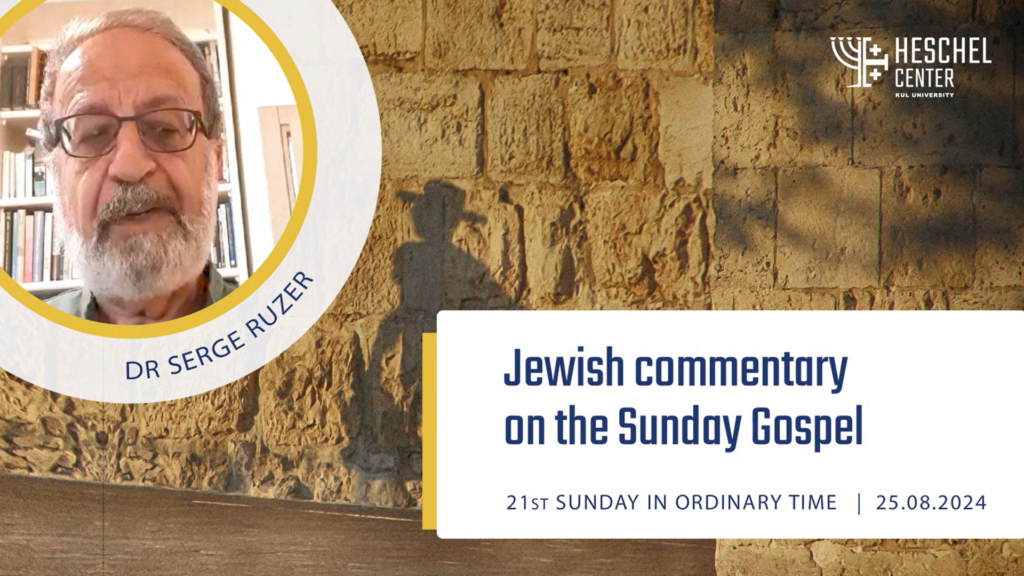Heschel Centre for Catholic-Jewish Relations at the Catholic University of Lublin
25 August, 2024
4 min
The Son of Man and his three meanings in Jewish tradition
“The appellation ‘son of man’ appears repeatedly in the Gospels, clearly referring to its use in broader Jewish tradition, where it had three distinctive meanings”, stresses Prof. Serge Ruzer, a professor at the Hebrew University of Jerusalem, in his commentary for the Catholic University of Lublin Heschel Center for the Sunday, August 25. The appellation […]

“The appellation ‘son of man’ appears repeatedly in the Gospels, clearly referring to its use in broader Jewish tradition, where it had three distinctive meanings”, stresses Prof. Serge Ruzer, a professor at the Hebrew University of Jerusalem, in his commentary for the Catholic University of Lublin Heschel Center for the Sunday, August 25.
The appellation “son of man” appears repeatedly in the Gospels, clearly referring to its use in broader Jewish tradition, where it had three distinctive meanings. First, in Jeremiah (49:18, 33, 50:40, 43) “son of man” or “son of Adam” equals “man” in general – all men. The same means “born of a woman” found in the Dead Sea Scrolls and in Galatians 4:4. In this general sense, the phrase is evoked in quite a few Gospel passages, for example, Mark 2:27-28 (and parallels): “And he said to them, ‘The sabbath was made for man, not man for the sabbath; 28 so the son of man is lord even of the sabbath’.” Jesus here answers the criticism that he allowed his hungry disciples to pluck heads of grain on Sabbath and argues that the immediate needs of men – here “man” is obviously synonymous with “son of man” – have preference to Sabbath ritual regulations. In this, he sides with a tendency to be attested in rabbinic sources (Mekhilta de r. Ishmael on Exodus 31:14): “The Sabbath has been handed over to you, not you to the Sabbath.”
Another meaning of the son-of-man/son-of-Adam phrase is attested throughout the book of Ezekiel and its multiple echoes in rabbinic literature: this is how God addresses the prophet there. This individual sense is very much present in the Synoptic tradition of Matthew-Mark-Luke, when Jesus speaks about himself, mostly in premonition of his future tragic fate. It might have been common to say “the son of man” instead of “I” when referring to something disastrous awaiting the speaker. There are cases where the distinction between the general and individual, pertaining to Jesus, is blurred, as in Luke 9:58: “Foxes have dens and birds of the air have nests, but the son of man has no place to lay his head.” Does it speak about the common human predicament? Or about Jesus specifically?
A third distinctive usage of the phrase is found in Daniel 7. Having described the world history as a consecutive rule of four evil empires, represented in the heavenly sphere by four horrible beasts, the vision portrayed the future age of redemption as epitomized by the “one like a son of man,” coming over the clouds and introducing the kingdom of God and the saints of Israel. It is unclear if this son-of-man was thought by the author of as a truly individual – even if angelic – figure, or as only as a symbolic representation of the glorious Israel.
However, already in the Parables of Enoch (1 Enoch 48) from early first century CE, the “son of man” from Daniel 7 was interpreted as a person; moreover, he is defined there – and the trend would be later picked up in rabbinic literature – as the Messiah. It is this third meaning of the son-of-man appellation, which is evoked, when the Synoptic Gospels speak about a future appearance of the Daniel 7 figure and identify him with Jesus who is one day to return as an angelic redeemer (Matt 26:64): “Jesus said to him, “… I tell you, hereafter you will see the Son of man seated at the right hand of Power, and coming on the clouds of heaven.”
In the Parables of Enoch, there was one more crucial development: if in Daniel 7 the son of man appears only at the end of times, in 1 Enoch 48, we are told that he, the Messiah, had existed in the heavenly sphere from before the creation and was imbued with all God’s wisdom. It seems that this upgraded version of the motif — absent in the Synoptic tradition of Matthew-Mark-Luke – is not only behind the Prologue of the Fourth Gospel, which speaks of the Messiah as the eschatological embodiment of God’s preexistent Logos, but is also referred in Jesus’ saying in John 6:61-62: “What if you were to see the Son of Man ascending to where he was before?”
About Author:
Prof. Serge Ruzer is a professor at the Hebrew University of Jerusalem, where he teaches in the Department of Comparative Religion. He has authored numerous articles and books on the Jewish background of the New Testament.
Related

Explaining Holy Week to Our Children: A Journey of Faith and Hope
Laetare
11 April, 2025
4 min

Christian Leadership in Business: A Model of Humility, Justice, and Solidarity
Javier Ferrer García
10 April, 2025
3 min

Guiding Our Decisions with God’s Will in Daily Life
Patricia Jiménez Ramírez
10 April, 2025
4 min

What are you going to do with your life?
Luis Herrera Campo
10 April, 2025
2 min
 (EN)
(EN)
 (ES)
(ES)
 (IT)
(IT)

